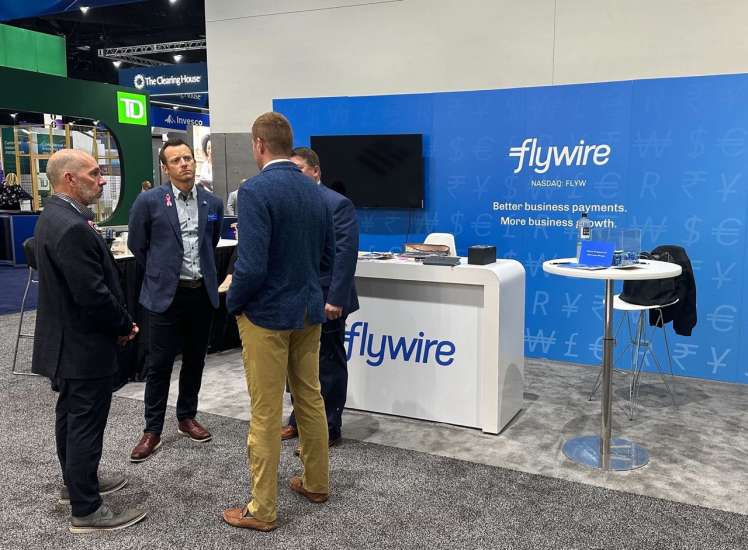The people who work in treasury and finance roles interact with every part of their companies. By extension, they sit at the center of lots of exciting, and very challenging, aspects of running a business right now.

That was evident in San Diego at this week’s AFP 2023 conference, where thousands of treasury and finance practitioners, banks, and vendors gathered for 3+ days of networking, learning and fun, with the goal of getting better at doing a job that’s only going to get more challenging. The scope of the roles and the stakes of the responsibilities are expanding – reflected in sessions spanning everything from combating fraud to navigating boardroom personalities.
The willingness to come together and camaraderie to talk through real problems and real solutions was on full display. What was the buzz at the event this year? Here’s some of what we saw and heard at the show.
- There’s concern over interest rates and inflation. High interest rates came up as a concern in every conversation with attendees – with at least seven sessions focused solely on how to best manage the impact. The impacts extend from managing FX risk, to debt, to hiring strategies (compensation is trending upward and compensation for positions is increasing, data from The Treasury Recruitment Company revealed). One piece of good news: Inflation has come down faster in the US than in other economies, renowned geopolitical expert Ian Bremmer told attendees gathered for his Tuesday afternoon keynote.
- Treasurers are balancing growth and cost. On a high note, several practitioners that Flywire spoke with led treasury departments of growing businesses. On the flip side of that is they’re taking on the role of advising on and mitigating the risks of global growth. Controlling costs is a priority, and there appears to still be a strong appetite to innovate and automate to gain efficiencies (as well as reduce DSO to get cash in faster and invest)– and attendees were eager to learn about new technologies and bring different partners together to do that.
- Geopolitical events are creating risk, but treasurers can navigate by narrowing focus. At a time when treasury pros are monitoring what seems an all-time high of news to sort a path through geopolitical uncertainty, AFP hit the nail on the head in providing a keynote with renowned geopolitical expert Ian Bremmer. In 40 minutes, he managed to somehow package advice on what exposure to expect from two wars, the US government, and US relations with China. His view in 4 seconds: there will be market impacts in Europe and Asia, the US dollar will remain strong and India and Mexico will be success stories.
- Artificial intelligence is getting (and in some cases already) real. One session called “How AI and Automation are Changing the Talent Treasury Game,” summed up the AI opportunity quite well: “AI enables that transformation from data crunchers to be elevated decision-makers.” Data quality is very much in vogue as these new technologies come into play – and many session presenters mentioned the importance of going back to data governance basics.
- Cybersecurity threat landscape, fraud, continues to increase. Businesses are fighting back, but still can’t stamp out a chief culprit: checks. To keep up with the increasing threat landscape (half of treasurers surveyed by AFP named cybersecurity risk as their most challenging one to manage), the cybersecurity workforce needs to grow by 65% to defend critical assets, according to data presented in a must-see session from Wells Fargo on “Mitigating Fraud Risk in Receivables and Payables.” There are many ways to mitigate the threat, we learned in that same session, and one of them is to phase out checks. But they’re persistent. As evidence: During a standing room only session on adopting RTP and FedNow, about half of the audience raised their hands to say that their businesses were still using checks.
- Treasury and finance are leading cross-departmental collaboration and driving positive change. Treasurers and financial professionals are playing a lead role in aligning stakeholders across departments to drive positive change. Part of that involves deeply understanding the business. Some advice? Go out on a sales call or walk a line on the shop floor, Jim Mancuso, CFO of Chosen Foods, advised attendees of his session, “The Evolution of the CFO Role and its Impact on Financial Performance Management.”
- Everyone’s still working through changing workforce expectations, without a perfect answer. The vexing questions over hybrid and remote work continues to be a conversation at many of the places practitioners work – with the majority agreeing that there needs to be a balance. The sweet spot for treasury and finance employees – like many other industries – is between 2-3 days in the office, according to data from The Treasury Recruitment Company (which held another standing room only session, “Achieving Career Success in the New Hybrid World of Remote and In-Person Teams”), or core weeks in-person.
- Tomorrow’s treasurer will be increasingly techy. At a session on the changing role of the CFO, Planful’s CFO Dan Fletcher shared that his team increasingly has data warehousing skills, as there’s a strong need for expertise around data integration and integrity. You’re no longer just looking at GL data. That’s expanded to integrating data around inventory, CRM, HRIS and more. It’s not unusual to now see Python programming skills in treasurer candidates.
- John Cena speaks Mandarin. In the spirit of the "never stop learning" vibe at the conference, the actor and professional wrestler was a perfect show opener. During his keynote, he fielded a question from an attendee in Mandarin, explaining how the WWE offered access to free language classes when it planned an expansion in China.
Learn more about challenges and opportunities for finance and treasury professionals, including:
- How ERP systems do (and don't) support international businesses
- Things to consider when picking a B2B cross-border payments solution
- Ways Flywire can help solve data and compliance challenges and accelerate payments
